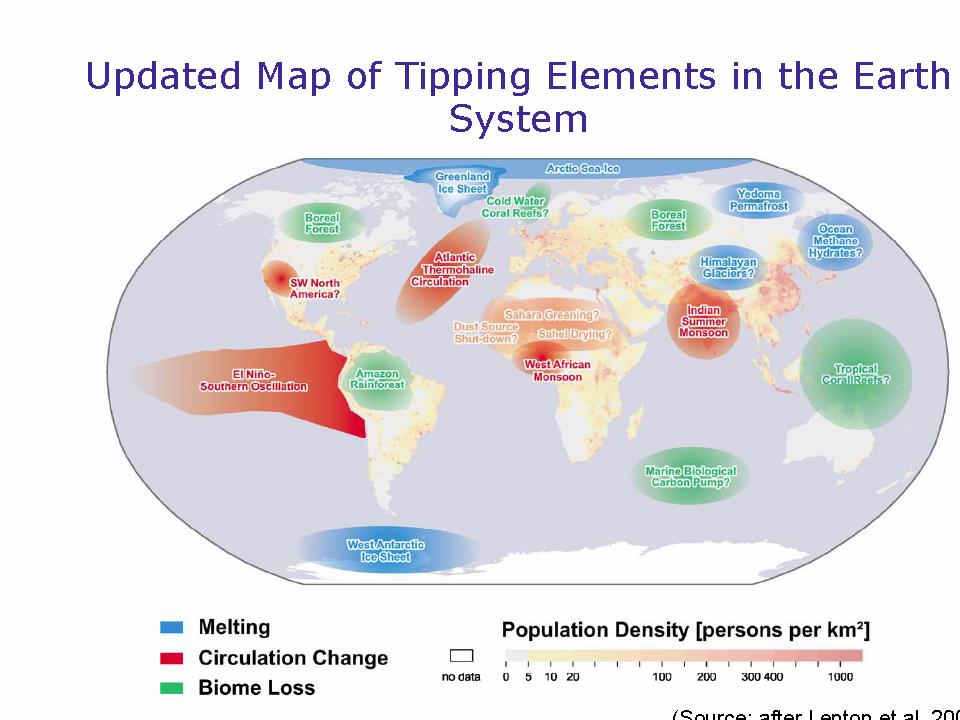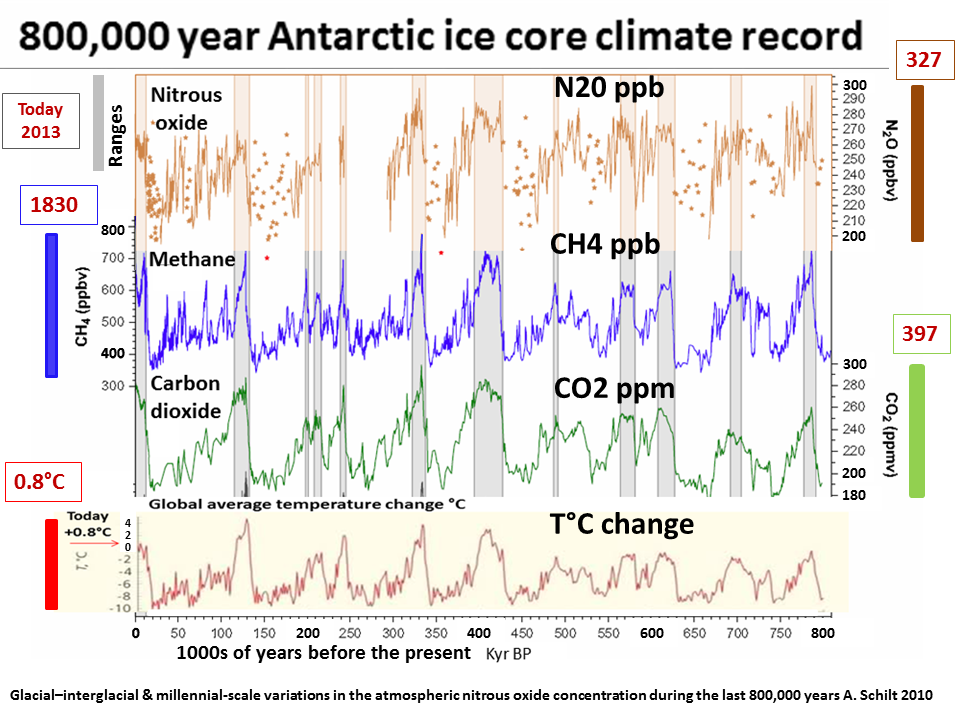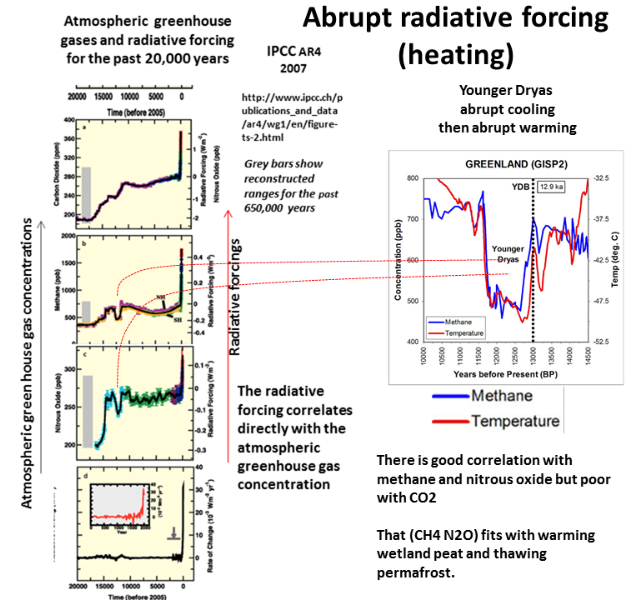Catastrophic Dangers
The climate change science presented here (including the IPCC) is agreed
that global climate change can be catastrophic, abrupt and irreversible.
We are in a state of planetary emergency because we face a number of global climate catastrophes.
There are three obvious greatest catastrophes.
1. Agricultural collapse - The collapse of regional or global agriculture would be a global catastrophe for humanity.
2. Arctic multiple, inter-reinforcing amplifying carbon feedback, rapid warming and runaway climate change would be a planetary catastrophe to all life.
3. Ocean collapse from heating, acidification and de-oxygenation, also a catastrophe to all life
Scientists in general avoid using the term climate catastrophe or even dangerous climate change.
The scientists refer to climate catastrophe as 'rapid temperature increase' , 'abrupt' global climate change, 'irreversible' climate change impacts, and 'large scale singularities'. The IPCC AR4 did refer to catastrophes in the technical report.
Under these headings the scientists generally cite the following:
o Shutdown of the thermohaline/meridional overturning circulation/'deep ocean conveyer' current- freezing Europe.
o Irreversible destabilization (slide into the ocean) of the Greenland ice sheet - sea level rise.
o Collapse of West Antarctic peninsula - sea level rise.
o Acceleration in the already rapid (6th mass Extinction event) extinction of species.
o Arctic summer sea ice tipping point has been recently included.
The IPCC assessments have recognized the possibility of climate change indiced catastrophes. The unrealistic linear treatment of global warming projections how ever incorrectly reduces the risk of tipping points. By excluding the carbon feedbacks from these global temperature projections the IPCC introduces another huge source of error excluding the greatest tipping point risk of all - carbon feedback runaway.
IPCC 2001 3rd assessment
The 2001 assessment recognized a number of potentially catastrophic effects
Projected climate changes during the 21st century have the potential to lead to future large-scale and possibly irreversible changes in Earth systems resulting in impacts at continental and global scales.
Examples include
significant slowing of the ocean circulation that transports warm water to the North Atlantic,
large reductions in the Greenland and West Antarctic Ice Sheets,
accelerated global warming due to carbon cycle feedbacks in the terrestrial biosphere, and
releases of terrestrial carbon from permafrost regions and methane from hydrates in coastal sediments.
The likelihood of many of these changes in Earth systems is not well-known,
however, their likelihood is expected to increase with the rate, magnitude, and duration of climate change
If these changes in Earth systems were to occur, their impacts would be widespread and sustained. For example, significant slowing of the oceanic thermohaline circulation would impact deep-water oxygen levels and carbon uptake by oceans and marine ecosystems, and would reduce warming over parts of Europe. Disintegration of the West Antarctic Ice Sheet or melting of the Greenland Ice Sheet could raise global sea level up to 3m each over the next 1,000 years 8 , submerge many islands, and inundate extensive coastal areas. Depending on the rate of ice loss, the rate and magnitude of sea-level rise could greatly exceed the capacity of human and natural systems to adapt without substantial impacts. Releases of terrestrial carbon from permafrost regions and methane from hydrates in coastal sediments, induced by warming, would further increase greenhouse gas concentrations in the atmosphere and amplify climate change.
IPCC 2007 4th assessment
Ice Sheets
Other global climate change catastrophes.
- preexisting multiple ongoing vulnerabilities,
- multiple impacts,
- cumulative impacts,
- climate system inertia, and
- global warming duration of milennia.
Vector borne diseases- increase and/or spread, global and regional
"The question now is whether we can avoid catastrophic human interference in the climatesystem." Prof John Holdren
Tipping points
Another very useful way science looks at climate change catastrophes is under the phenomenon of 'tipping points'. The term ‘‘tipping point’’ commonly refers to a critical threshold at which a tiny perturbation can qualitatively alter the state or development of a system. It involves positive amplifying feedbacks (T Lenton). It is inferred that a major planetary system is involved and the new state is irreversible and less supportive of life. The entire planet or biosphere may be approaching a tipping point.
Hans Scellnhuber has provided a map of all the global climate change tipping points from various sources that includes:
Arctic summer sea ice, Greenland ice sheet, Boreal forest, cold water corals, Atlantic thermohaline circulation, yedoma permafrost, ocean methane hydtrate, Himalayan glaciers, Indian summer monsoon, SW N America (drought), Amazon rain forest, Sahel drying, W Africa monsoon, Indian summer monsoon, tropical coral reefs, marine biological pump.
Agriculture. The environmental conditions required for the managed ecosystems human agriculture have existed over the past 10,000 years and they are now specific and quite narrow for global agriculture. We know ecosystems, small and large, can reach an ecological tipping point and suddenly collapse. We can conclude the same is more the case for agriculture.
Arctic methane. There are multiple +ve Arctic amplifying feedbacks to warming, with an enormous amount of methane emission potential (as well as CO2 and nitrous oxide), that can only be expected to lead to a tipping point for the Arctic, the Northern hemisphere and the biosphere.
As 'abrupt climate change' or 'rapid warming' the ice core science shows this is happened in the past and the most recent one (the post Younger Dryas) was caused by methane emissions.
The past climate change heats up PNAS 2000
Steven M. Stanley
Research has provided a shocking new assessment of the speed with which major climate changes can sweep across our planet.
The most precise evidence of rapid climate change comes from cores extracted from mountain glaciers and from the larger ice sheets of Greenland and Antarctica. Annual layers in the glacial ice provide the chronology and key data on snowfall, temperature, influx of dust, and trace gases from the ancient atmosphere trapped in air bubbles.
There is ominous evidence that, during the past few thousand years, Earth's climate has been anomalously tranquil compared to its behavior during the preceding hundred thousand years.
Ice-core evidence of abrupt climate changes
Richard B. Alley
Ice-core records show that climate changes in the past have been large, rapid, and synchronous over broad areas extending into low latitudes, with less variability over historical times. These ice-core records come from high mountain glaciers and the polar regions, including small ice caps and the large ice sheets of Greenland and Antarctica.
As the world slid into and out of the last ice age, the general cooling and warming trends were punctuated by abrupt changes. Climate shifts up to half as large as the entire difference between ice age and modern conditions occurred over hemispheric or broader regions in mere years to decades. Such abrupt changes have been absent during the few key milennia when agriculture and industry have arisen.
UN Climate News 3 May 2018 At the 2018 on climate change meeting the world holds organization world health organization warned that records for extreme weather events are being broken at an unprecedented rate and that there is a real risk for the world to lose its capacity to sustain human life if the Earth's climate is further altered by adding evermore heat trapping greenhouse gases




